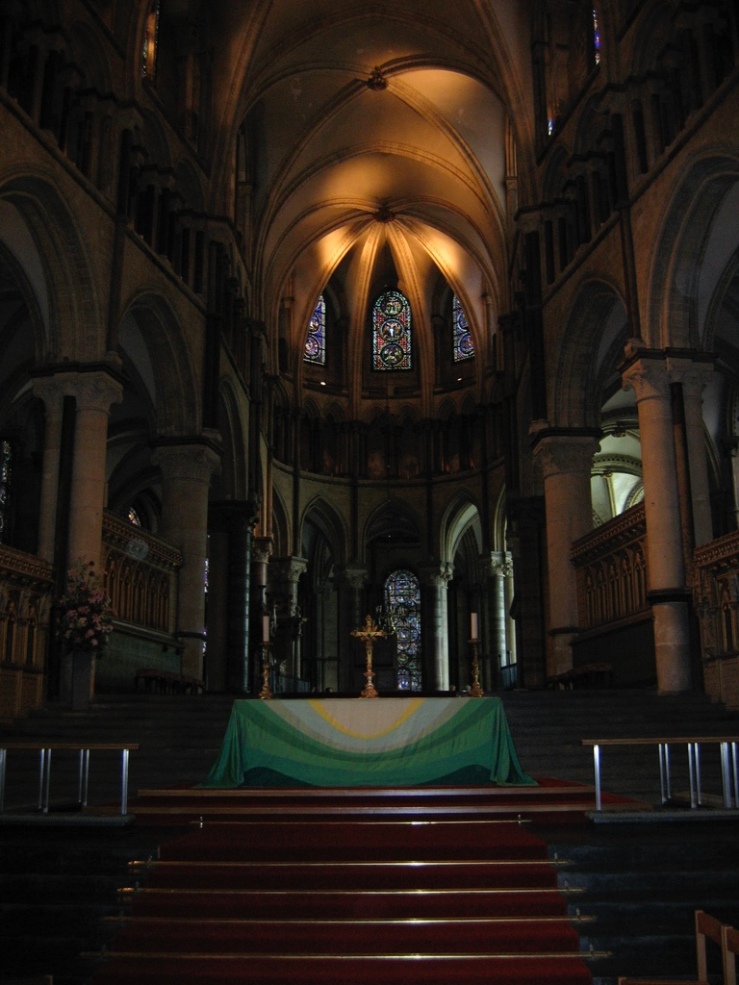
Yesterday, the world watched in sadness and sometimes in quiet song as vast portions of Notre Dame Cathedral came down in a blaze. Many mourned the loss of a place of such history and culture. But even more mourned the loss of a great bastion of beauty in the world. Tears were shed by some who had never even visited the Cathedral (my crying-averse self hesitantly admits that I was one of them), because we know that spaces devoted to glorious, “impractical,” fairy-tale-like beauty are rare anymore and unlikely to be replaced.
I have never had the pleasure of visiting Notre Dame Cathedral, but I’ve been to Europe on a couple different occasions and visited other beautiful, magnificent cathedrals and ancient churches. The sense of sacred mystery and serenity that permeate these places is forever stamped on my heart. The craftsmanship that looks past what is useful to what is elevating; the details that sing out that even what goes unnoticed or unseen in this world matters if it is done rightly; the great sacredness of a space set aside for prayer and worship, a safe hiding place for weary souls – these things matter. I knew this even as a teenager, though I couldn’t put it into words. The first time I encountered a prayer chapel in a great cathedral, I wanted to kneel down. I wanted to pray or chant or somehow use my own life, my own body to join in the quiet, tender sacredness of this place of beauty.
I pray that this fire will teach us to value anew the crucial nature of sacred beauty in our lives and in our churches. As my seven-year-old son and I watched the blaze on my phone, he asked why this church was so special. I told him that it was hundreds upon hundreds of years old and had witnessed so much of human life come and go. But more importantly, I told him, it was a space of sane beauty in a utilitarian, hurried world. And those are rare. I told him that anymore, our churches are built to be cheap and useful, but rarely is any thought put into how we can honor God by making them beautiful. I told him to look outside at the blooming mountainside and the sloping green fields, speckled with cows and their sweet, energetic calves. “Look how beautiful it is!” I said, “God made that! We know that he cares about beauty because he created with beauty even when he didn’t have to.” My son then asked if we sin when we don’t build and nurture beauty, and I told him, perhaps it wasn’t a sin, just a sign that we aren’t mature and don’t fully understand the goodness of God. But then, my sweet and serious-minded boy looked at me and said, “But what I want you to tell me is how we can make our own churches more beautiful.”
Oh my little man, that is indeed the question.
It’s true that beauty can’t create true faith. Europe is full of beautiful churches and populated by people without faith.
But beauty still matters.
Beauty draws us toward sanity and goodness, in a world oftentimes bent only on pettiness, on consumption, on self, on destruction. In a world of anger and friction, places of beauty call us toward peace, toward remembering that there is something higher and better than we oftentimes remember in our daily lives. Beauty is not the destination of the journey, but it is a gloriously soul-nourishing gift as we make our way toward God himself.
I think one of the fears that keeps us as Protestant Christians shying away from a commitment to beauty is a perhaps misguided fear that beauty leads to selfishness and a futile obsession with getting more and more stuff, that beauty is a distraction from the really important truths of Scripture.
As a girl, I was so torn and confused between the emphasis I received in my religious training on not being “materialistic” and the way that the books I read and the natural world I loved so much and the Bible itself seemed to communicate that God lived in the great details of beauty and in caring for the material world. Many voices told me that materialism was one of the great sins of our modern world and that truly devout followers were not distracted by things that were not of the Spirit.
But the God we serve is the God of the material world. He took a physical void and filled it with good things. He created and shared richly of color and texture and taste and smell. He ordered the construction of a temple of worship that was gloriously elegant and detailed. But perhaps most importantly, he was fully God and fully man. He lived a human life. He cooked. He tended broken bodies. He wiped tears and gave hugs. And when he makes all things new, it won’t be a disembodied ethereal existence we experience, but perfected bodies, nourishing feasts, soaring music, and beauty for all the senses.
True beauty is not idolatrous because true beauty points to the highest beauty of all – God himself. True beauty moves us towards humility and generosity. When we create, if we create rightly, it moves us to share. We clean and order a house with detailed attention so that we may bless those who enter it and so that in that space, we may help restore their souls. We bake bread and stir pots of soup to share with our loved ones and our neighbors to nourish their tired bodies. We make music so that others may hear it and paint pictures so that others may see them. And when we do all these things with attention to the goodness of God and an eye to making him known in our own souls and in the souls around us, we encourage our hearts to wait patiently and long expectantly for the day when His Kingdom will come and bring goodness and beauty and truth to their fullness.
May the ashes of Notre Dame move us – but not simply to woeful exclamations of resignation or to a commitment to be more advanced tourists who see all the world’s sights before they’re gone. May it move us to a commitment to fostering beauty and peace in even the smallest details of our lives, in order to restore hearts and glorify God.
I’ll leave you with this quote from one of my favorite books, The Supper of the Lamb:
Why do we marry, why take friends and lovers, why give ourselves to music, painting, chemistry, and cooking? Out of simple delight in the resident goodness of creation, of course; but out of more than that too. Half of earth’s gorgeousness lies hidden in the glimpsed city it longs to become. For all its rooted loveliness, the world has no continuing city here; it is an outlandish place, a foreign home, a session in via to a better version of itself – and it is our glory to see it so and thirst until Jerusalem comes home at last. We were given appetites, not to consume the world and forget it, but to taste its goodness and hunger to make it great.
(Capon, 189)

I was so sickened to see Notre Dame burning. But one of the first things I thought was that I wanted to read an article that would take in this tragedy and give me some hope or comfort. Or at least affirm that Notre Dame’s epic beauty matters in the Christian world today. I wanted something to tell me that shedding tears for a burning building that had lost its usefulness and was already falling apart is declaring the reality of God. He is good and beautiful.
Thanks for writing! You have encouraged me!
LikeLiked by 1 person
“And when he makes all things new, it won’t be a disembodied ethereal existence we experience, but perfected bodies, nourishing feasts, soaring music, and beauty for all the senses.
True beauty is not idolatrous because true beauty points to the highest beauty of all – God himself. True beauty moves us towards humility and generosity.”
Yes, yes, YES! I can’t tell you how deeply I needed this piece in this season, Kristen. You are breathing life with your words, and with your heart so full of beauty. ❤
LikeLike